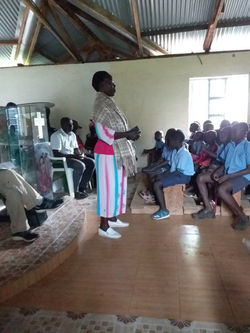

JONYO INTEGRATED
PRIMARY SCHOOL
 |  |  |
|---|---|---|
 |  |  |
 |  |  |
 |  |  |
 |  |  |
Thanks to you, Growing Community Roots raised $38,500 to provide for the school that includes a roof water catchment system that has four 10,000-liter tanks, shipping, piping, and installation for the tanks, one 8-door toilet and bathroom for girls, one-8 door toilet and bathroom for boys, one washing stand, and fencing for the garden. Jonyo Integrated Primary School has a
well-maintained tree garden though unfenced.


BACKGROUND
The Joyno Integrated Primary School is located in the Nyanza Province of Kenya, Africa. Its 2.47 acres are in West Rachuonyo Sub County, Kokoth A Kataa location, a sub country of Homa Bay County. The school was established by the Roman Catholic Church in 1982 on land donated by the community at the foot of Mount Homa, popularly known as
Homa Hills.
Joyno Primary Integrated School has a total of 352 students – 184 girls and 168 boys. There are 11 teachers, 8 are employees of the school, one is a county teacher and two are Board of Management members. The population surrounding the school is more than 5,000. Many are single parents and student parents orphaned by HIV/AIDS. Grandparents take care most of these students;
one-third of the student population are students during the day and parents to themselves and their younger siblings in the evening. This has caused a high student dropout rate at an early age because their workload is simply overwhelming. Many of the girl students end up marrying rather than trying to be parents to their siblings and attend school.
The local people are low-income earners who live on less than a dollar a day. The main occupation is fishing that is not sustainable because it is done on a small scale. They cannot provide the funds to install water catchment systems or construct toilets at the
primary school.

SIGNIFICANT NEED IDENTIFIED
Because of the school’s close proximity to Lake Victoria, it is assumed to have a clean source of water. However, Lake Victoria has been polluted for years with four different countries dumping waste into the lake. It is too far for the children to carry water for their use at the school. Girls suffer the most without access to safe water because they stay at home for three days or so during their mensal monthly days.
There is one old 3,000-liter water tank installed by NORAN, an NGO, in the 1990s. NORAN constructed 11 classrooms that can hold four 10,000-liter water catchment systems. In addition, there is a need for a washstand, and fencing for a garden that will greatly
aid the new national education system called Competency Based Curriculum.
Both the Board of Management and Parents Teachers Association have committed to see to the project’s completion and maintenance. The Head Teacher Ajiwu Patrick Otieno and the Deputy will be on the ground to make sure all goes well during and after the construction. There is significant need to replace the dilapidated “Out Houses” with toilet buildings with roofs. In addition, there is a need for a washstand, and fencing for a garden that will
greatly aid the new national education system called Competency Based Curriculum.
Both the Board of Management and Parents Teachers Association have committed to see to the project’s completion and maintenance. The Head Teacher Ajowi Patrick Otieno and the Deputy will be on the ground to make sure all goes well during and after the construction.
